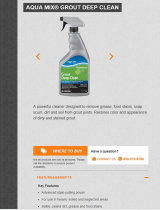
8431 Santa Monica Boulevard Los Angeles, CA 90069-4924 U.S.A
Tel: 323-650-2000 www.emser.com
Cleaning Porcelain and Ceramic
Porcelain and ceramic tiles are among the easiest flooring materials to clean. Due to their impenetrable glazes,
their surfaces are resistant to water, dirt, chemicals, oil, debris, and even germs and bacteria.
It is highly recommended to sweep or vacuum the surface prior to washing it with water to prevent the tile from
becoming muddy or leaving a residue after cleaning. Although the glaze of a tile is resistant to staining it is not
always chemical proof and in some cases may discolor if exposed to certain chemicals for extended periods of
time.
Always Remember:
• Do not clean porcelain tile flooring with ammonia or with cleaners that contain bleach and/or acid. Acid
and ammonia based cleaners may modify grout color and stability.
• Use a cleaner that is pH neutral. This ensures cleaning will not harm your grout or surrounding
surfaces.
• Do not use wax, oil-based, abrasive cleaners, or sealants.
• Use rugs at entrances to prevent dirt and grit from being tracked onto the tile flooring from outdoors.
Tiles are scratch resistant but not scratch proof.
• Do not use steel wool pads to remove tough debris or stains. Steel wool may scratch your tiles and
loose steel particles may eventually create rust stains in the grout over time.
Standard Cleaning of Glazed Products
For glazed tiles, use the following instructions for general cleaning:
1. Sweep or vacuum loose dirt and dust from the floor. On textured surfaces sweep in multiple directions.
First follow the direction of the tile, and then sweep diagonally. This will ensure the removal of all foreign
material that might be residing in the textured surface. For wall surfaces tile can be gently wiped down
with a clean, dry cloth or rag.
2. Mop the floor with a mild detergent, degreaser, or tile cleaning solution. For textured floors, the use of a
medium bristle brush is recommended. A sponge or clean cloth can be used to apply the cleaning
agent to wall surfaces.
3. Rinse the tile thoroughly with clean water to remove any left-over detergents.
4. Drying with a clean cloth or rag is recommended to increase the shine and to prevent water spots.
Cleaning Post Install-
Cleaning is a necessary step at the end of each job. The inappropriate or late removal of the residues may
leave streaks that are difficult to remove at a later time. These streaks can form into a cement film on the floor
that will absorb every type of dirt, giving the impression that the material is constantly dirty.
To remove cement fillers:
1. Wash the floor with a heavy duty tile and grout cleaner which is a solution ready to use straight out of
the bottle. If necessary a water and acid solution must be used to cut through heavier film.
2. Follow manufacturer’s instructions closely regarding application and clean up.
3. Rinse floors thoroughly with water to ensure that the floor is free from detergents or residues. If needed,
the operation can be repeated.










